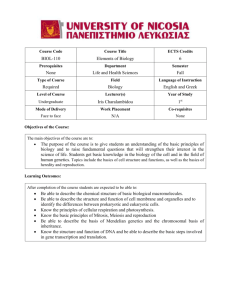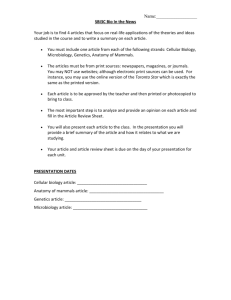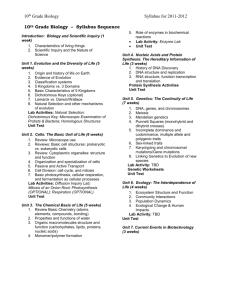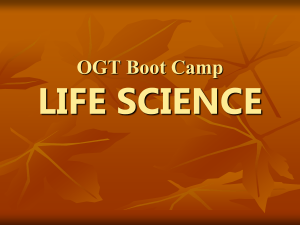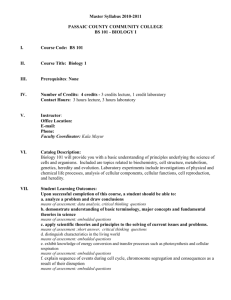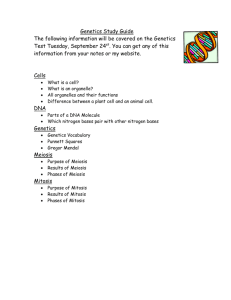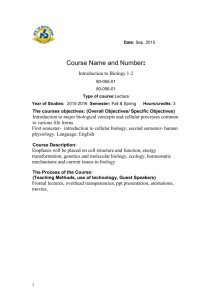Principles of Biology I_Syllabus_Fall 2015
advertisement
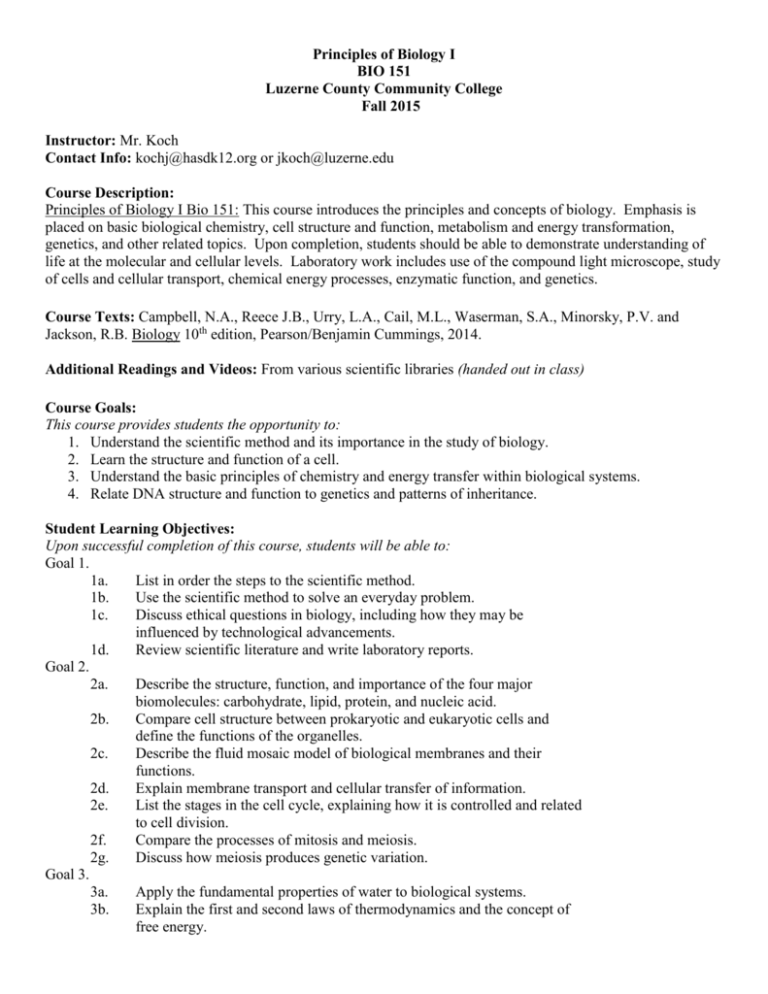
Principles of Biology I BIO 151 Luzerne County Community College Fall 2015 Instructor: Mr. Koch Contact Info: kochj@hasdk12.org or jkoch@luzerne.edu Course Description: Principles of Biology I Bio 151: This course introduces the principles and concepts of biology. Emphasis is placed on basic biological chemistry, cell structure and function, metabolism and energy transformation, genetics, and other related topics. Upon completion, students should be able to demonstrate understanding of life at the molecular and cellular levels. Laboratory work includes use of the compound light microscope, study of cells and cellular transport, chemical energy processes, enzymatic function, and genetics. Course Texts: Campbell, N.A., Reece J.B., Urry, L.A., Cail, M.L., Waserman, S.A., Minorsky, P.V. and Jackson, R.B. Biology 10th edition, Pearson/Benjamin Cummings, 2014. Additional Readings and Videos: From various scientific libraries (handed out in class) Course Goals: This course provides students the opportunity to: 1. Understand the scientific method and its importance in the study of biology. 2. Learn the structure and function of a cell. 3. Understand the basic principles of chemistry and energy transfer within biological systems. 4. Relate DNA structure and function to genetics and patterns of inheritance. Student Learning Objectives: Upon successful completion of this course, students will be able to: Goal 1. 1a. List in order the steps to the scientific method. 1b. Use the scientific method to solve an everyday problem. 1c. Discuss ethical questions in biology, including how they may be influenced by technological advancements. 1d. Review scientific literature and write laboratory reports. Goal 2. 2a. Describe the structure, function, and importance of the four major biomolecules: carbohydrate, lipid, protein, and nucleic acid. 2b. Compare cell structure between prokaryotic and eukaryotic cells and define the functions of the organelles. 2c. Describe the fluid mosaic model of biological membranes and their functions. 2d. Explain membrane transport and cellular transfer of information. 2e. List the stages in the cell cycle, explaining how it is controlled and related to cell division. 2f. Compare the processes of mitosis and meiosis. 2g. Discuss how meiosis produces genetic variation. Goal 3. 3a. Apply the fundamental properties of water to biological systems. 3b. Explain the first and second laws of thermodynamics and the concept of free energy. 3c. 3d. 3e. 3f. Define chemical reaction using the synthesis and degradation of the biomolecules and contrasting exergonic and endergonic reactions. Describe basic enzyme structure and function. Explain the concepts of oxidation and reduction. Explain how ATP drives cellular work through the processes of glycolysis, citric acid cycle, electron transport, and fermentation. Goal 4. 4a. 4b. 4c. 4d. Explain the processes of DNA replication and gene expression. Describe mutation and distinguish between the various types of mutation. Distinguish between Mendelian genetics concepts of complete dominance, incomplete dominance, codominance, multiple alleles, pleiotropy, epistasis, and polygenic inheritance. Explain expression of Mendelian traits through monohybrid and dihybrid genetics problems. Policies: Attendance of each lecture and lab is required. If a class or lab is missed due to an emergency, I expect to be informed of the cause. Students are responsible for all lecture materials and reading assignments whether they attended class or not. Any lecture notes that you have missed should be obtained from a classmate. If excessive absences occur the student will receive a grade of “I” (incomplete), and have to retake the course. Students will have opportunities to ask questions in class, but extensive questions about course material, grades, or exams should be brought to office hours. Exams must be taken on the scheduled date. Write these dates on your calendar. Makeup exams will only be given to students who provide documented evidence of a family or health emergency, and may be of a different format from the regularly scheduled exam. Makeup exams will be given at a time of the instructor’s choosing. If you have a documented learning disability, you may be entitled to certain considerations, such as extra time during the exams. You must see me prior to the exam date to make the appropriate arrangements. Academic Misconduct: Students engaged in academic misconduct, such as plagiarism or cheating on an exam or other assignment will be given a zero for the assignment or exam. At the discretion of the instructor all students involved in cheating may be failed for the course. Each case of misconduct will be brought before the Student Development Office and may result in expulsion from the college. Inclement Weather/Snow Policy: In the event of inclement weather, commuting students should take their own safety into account first. If LCCC is open, I will make every effort to be here for class. If school remains open, but I am unable to be in class, I will attempt to notify every student through email. If you have a difficult drive and you deem it imprudent to attempt to drive in for safety reasons, please leave a message with the college to that effect, or send me an email message. You will still be responsible for any material missed in that class. Grading: 1st Half Exam #1 (10%) Midterm Exam (Covers all of 1st half) (20%) Quizzes (4 – dropping the lowest each half) (5%) Projects (3 each half) (20%) Labs (6 each half) (20%) Class Participation (25%) 2nd Half Exam #2 (10%) Final Exam (Cumulative 1st and 2nd half) (20%) Quizzes (4 – dropping the lowest each half) (5%) Projects (3 each half) (20%) Labs (6 each half) (20%) Class Participation (25%) Grade Determination: A grade will be awarded for this course on the following basis. A B+ B C+ = = = = 93% – 100% 89% – 92% 85% – 88% 81% – 84% C D+ D F = = = = 77% - 80% 73% - 76% 70% - 72% 69 and below Example: 1st Half Exam #1 – 80 x 0.10 = 8 Midterm Exam – 90 x 0.20 = 18 Quiz #1 – 90 Quiz #2 – 85 ->dropped Quiz #3 – 100 Quiz #4 – 90 Quiz Grade 93 x 0.05 = 4.7 Project #1 – 95 Project #2 – 90 Project #3 – 95 Project Grade 93 x 0.20 = 18.5 Lab #1 – 90 Lab #2 – 80 Lab #3 – 85 Lab #4 – 90 Lab #5 – 75 Lab #6 – 80 Lab Grade 83 x 0.20 = 16.7 Class Participation 95 x 0.25 = 23.8 1st Half Grade (8 + 18 + 4.7 + 18.5 + 16.7 + 23.8) = 90% or B+ 2nd Half Exam #2 – 90 x 0.10 = 9 Final Exam – 80 x 0.20 = 16 Quiz #5 – 80 ->dropped Quiz #6 – 85 Quiz #7 – 100 Quiz #8 – 90 Quiz Grade 92 x 0.05 = 4.6 Project #4 – 85 Project #5 – 90 Project #6 – 90 Project Grade 88 x 0.20 = 17.5 Lab #7 – 95 Lab #8 – 85 Lab #9 – 80 Lab #10 – 90 Lab #11 – 75 Lab #12 – 70 Lab Grade 83 x 0.20 = 16.7 Class Participation 95 x 0.25 = 23.8 2nd Half Grade (9 + 16 + 4.6 + 17.5 + 16.7 + 23.8) = 88% or B Final Grade (Average of 1st and 2nd Half Grades) = 89% or B+ Tentative Sequence of Lecture Topics 1. Properties of Water 2. Evolution & Ecology 3. Macromolecules 4. Cellular organization and transport 5. Thermodynamics and energy transfer 6. Mitosis/Meiosis 7. DNA and Genetics 8. Biotechnology Tentative Laboratory Schedule 1. Properties of Water 2. Artificial Selection 3. Animal Behavior 4. Microscope & Cell Structure 5. Osmosis & Diffusion 6. Enzymes 7. Energy 8. Photosynthesis, Cellular Respiration, & Fermentation 9. Cell Reproduction: Mitosis and Meiosis 10. Genetics 11. Biotechnology I – DNA extraction and determination 12. Biotechnology II – PCR and Restriction Enzyme Analysis; DNA analysis by gel electrophoresis Tentative Projects Project #1 – Darwin Project Project #2 – Clay Caterpillars Project #3 – Independent Project Project #4 – PA Trout in the Classroom Project #5 – Bioethics Project #6 – Independent Project Tentative Course Schedule: September: Darwinian Evolution Darwin Project (ongoing) Artificial Selection: Lab 1 Sustainable Garden Project (ongoing) Ecology Clay Caterpillar Project (ongoing) Animal Behavior: Lab 12 Chemistry and Organic Molecules The Biology Project: Biochemistry – University of Arizona Website Activity Identifying Macromolecules in Our Foods Activity Enzyme Activity: Lab 13 October: Cell Structure and Function Cells Alive! Website Activity Microscope Techniques for Observing and Measuring Different Types of Cells Activity Cell Transport and Homeostasis Diffusion and Osmosis: Lab 4 November: Energy Energy Dynamics: Lab 10 PA Trout in the Classroom Activity (ongoing) Photosynthesis Stomata Peel Activity Photosynthesis: Labs 5 Cellular Respiration Cellular Respiration: Lab 6 Alcoholic and Lactic Acid Fermentation Activity December: Cell Communication and the Cell Cycle Cell Division: Mitosis and Meiosis: Lab 7 Cancer The Biology Project: Cell Biology – University of Arizona Website Activity Mendelian Genetics The Biology Project: Mendelian Genetics – University of Arizona Website Activity Learn. Genetics – University of Utah Website Activity Mathematical Modeling: Hardy-Weinberg: Lab 2 Protein Synthesis Comparing DNA Sequences to Understand Evolutionary Relationships with BLAST: Lab 3 Epigenetics Learn. Genetics – University of Utah Website Activity Genes and Gene Regulation PhET Simulations – University of Colorado Website Activity January: Biotechnology Learn. Genetics – University of Utah Website Activity Biotechnology: Bacterial Transformation: Lab 8 Biotechnology: Restriction Enzyme Analysis of DNA: Lab 9 Bioethics (Stem Cell Research, Antibiotic Resistance and the Problems with Improper Antibiotic Use, Genetically Modified Food, The Use of Genetic Information) National Center for Case Study Teaching in Science (NCCSTS) – University at Buffalo Website Activity
